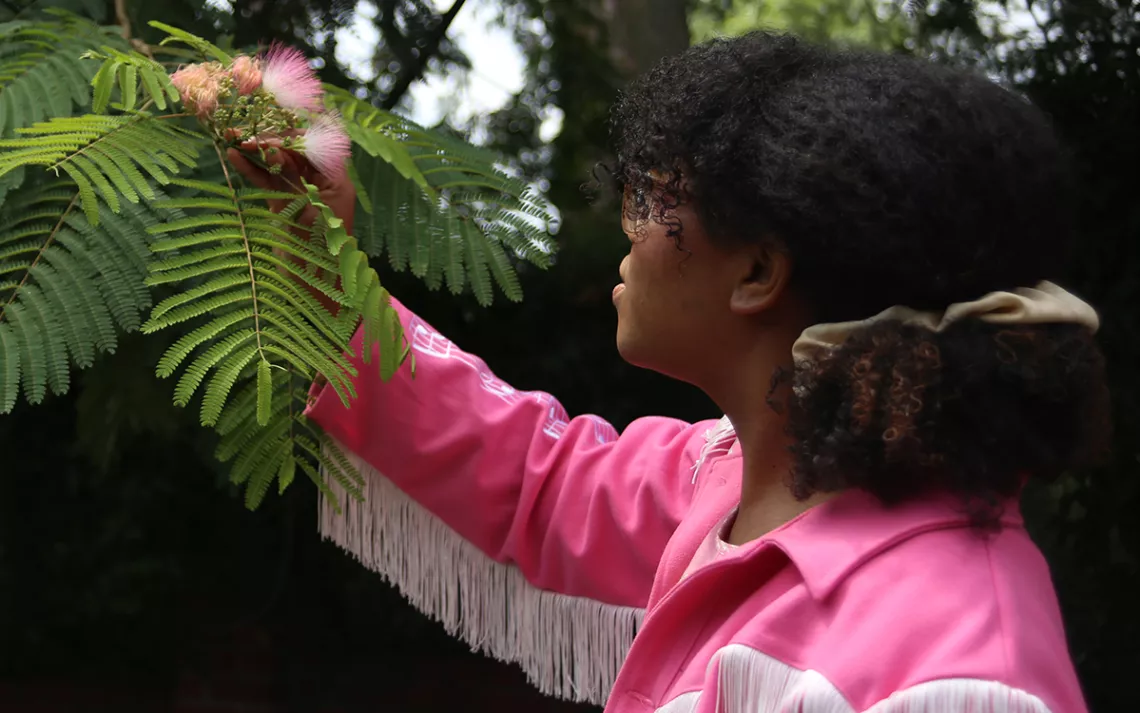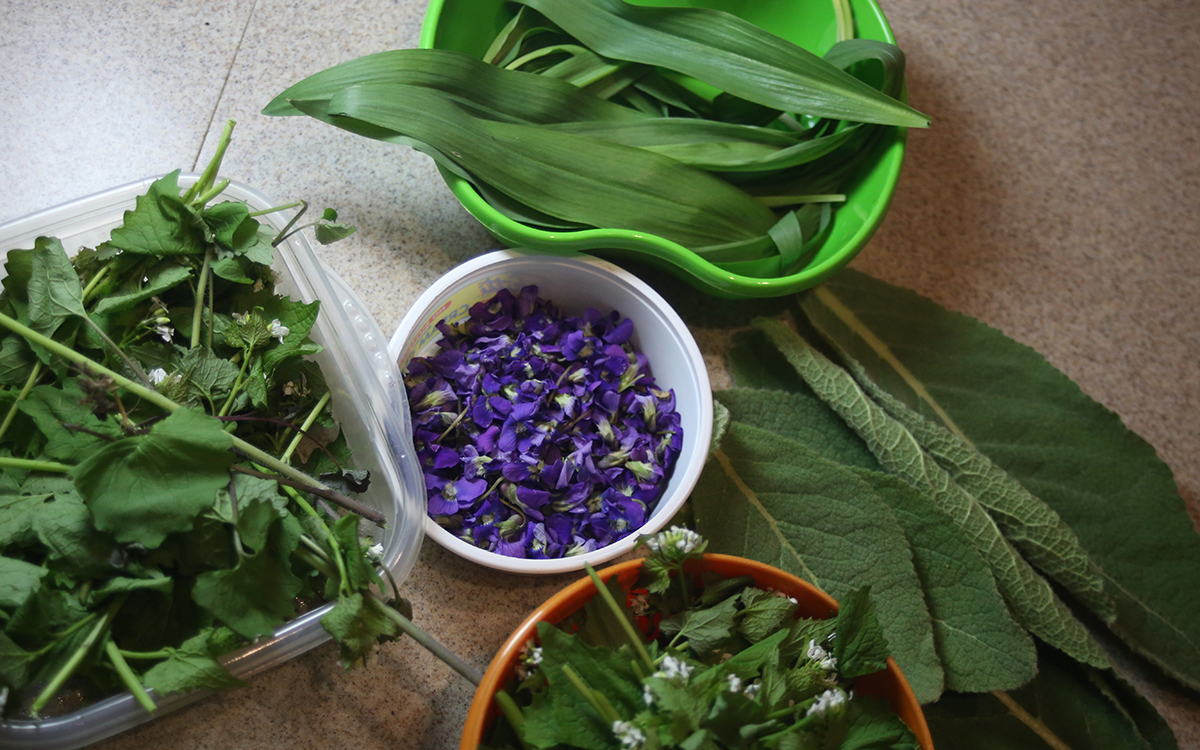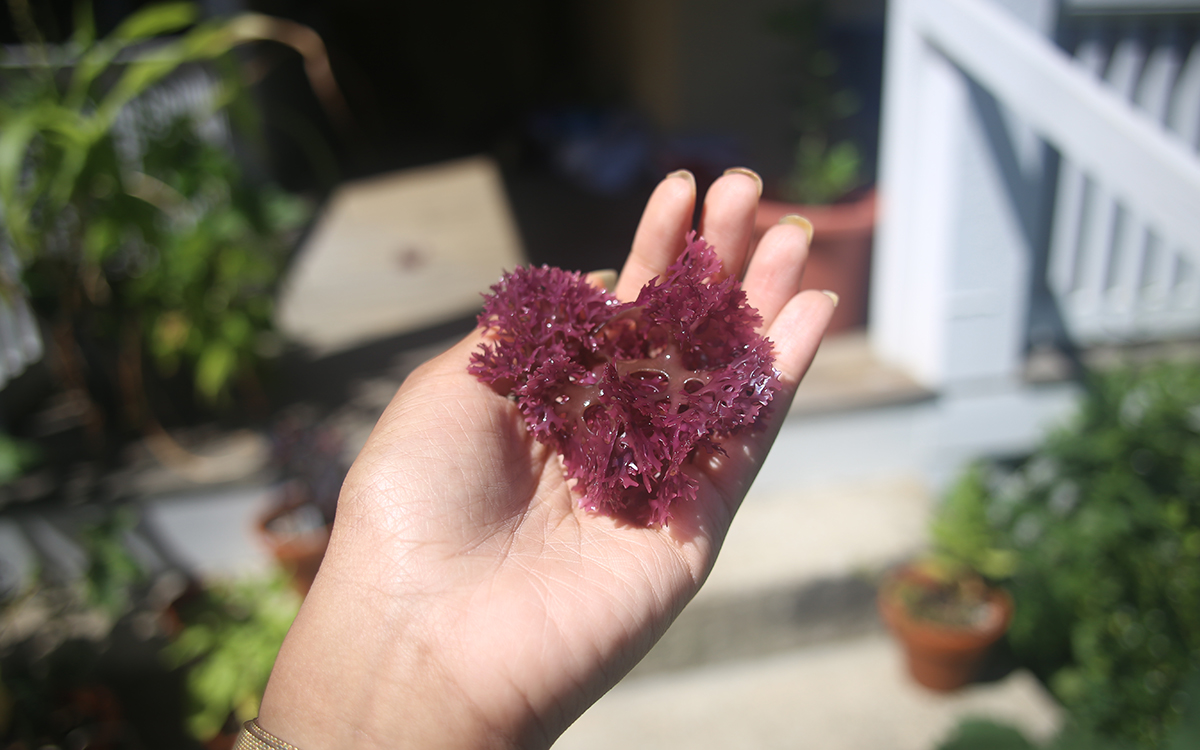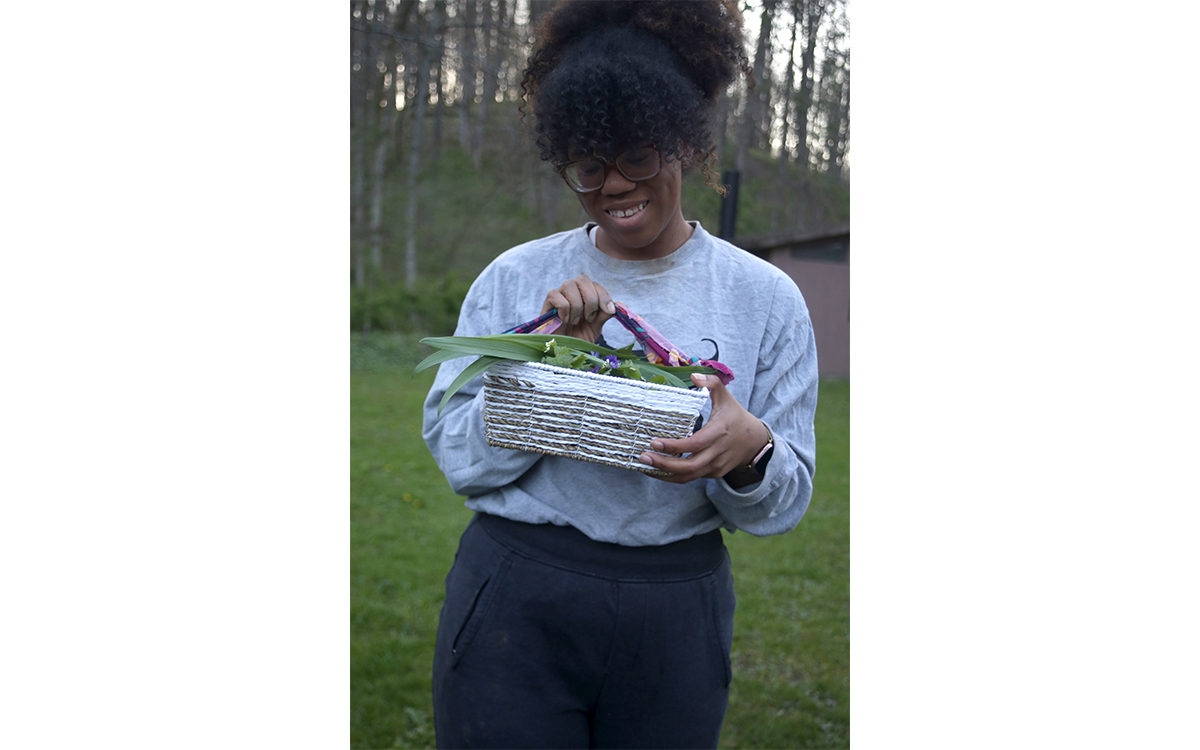Wild Food for All
Despite barriers, BIPOC foragers are reclaiming centuries-old traditions

Alexis Nikole Nelson inspects mimosa blossoms (albizia julibrissin). These can be turned into cordials and tinctures, among other uses. | Photos courtesy of Alexis Nikole Nelson
Before the COVID-19 pandemic, Alexis Nikole Nelson was known by her coworkers for the mostly empty backpack she carried to the office each morning; on her 45-minute walk home, she’d stuff it with weeds like burdock, mugwort, and field garlic along with wild fruits like Juneberries. Nelson would often stop by a river to gather many of these plants—part of a commute blissfully free of stuffy trains and incessant traffic. She would then incorporate her foraged bounty into food that she made: syrups, breakfast tacos, and even caprese.
Based in Columbus, Ohio, Nelson has still managed to forage in recent months while staying close to home and working remotely as a social media manager. And others want in on her gathering know-how: By sharing her tips and recipes, she picked up a quickly growing audience of more than 240,000 TikTok followers. In an April 8 video, Nelson asks viewers, “A little afraid of going to the grocery store right now?” She quickly cuts to clips of plants to forage within your own neighborhood, including garlic mustard (“super invasive, but it’s also super good for you”), dandelion flowers (you can dip them in batter and fry them), and the common dog violet (perfect for syrup that turns pink when you add lemon juice).
Although she enjoys wandering solo when she forages, Nelson has connected with a highly active online community that bonds over wild foods. Known as @blackforager on Instagram, Nelson says she’s met more POC gatherers there than on any other platform. “So many of us grew up with these little pockets of knowledge that were passed on to us by parents, by grandparents, by neighbors, that we’re just holding on to,” Nelson says.
That’s certainly true for Nelson. She learned how to garden from her mother, though she found the sprouting weeds more useful than anything they planted. Her father is a foodie, she says, who shared with her the foraging knowledge that is part of his Southern and Indigenous heritage. She also credits a summer camp north of Cincinnati that she attended while growing up, where she ran through the forest each day and learned the names of trees and plants “like they’re friends.”

A collection of foraged ramp leaves, violets, garlic mustard, and mullein from one of Nelson’s outings.

Nelson gathers Irish moss (chondrus crispus), which can be used in smoothies and desserts.
While she’d always been into foraging, being “broke as hell” as a recent college graduate inspired her to get creative and draw on know-how from botany, chemistry, and biology courses that she took at Ohio State University. These days, it’s particularly useful to cook with gathered food because her nearest grocery store requires a long walk or bus ride. Nelson says that, like other urban areas around the country that have been systematically deprived of quality grocery stores, her neighborhood lacks access to healthy food.
People of color and low-income communities have long gathered ingredients for meals, and foraging can help fill in the gaps in places where historic redlining has had lasting effects on supermarket options. In fact, some wild and feral foods can provide greater nutritional benefits than produce bought in stores.
But like many minority- and working-class-led movements, foraging has been co-opted in recent decades by wealthy, mostly white elites. It’s now embraced by everyone from world-renowned Scandinavian chefs to environmentalists scouting food on leisurely hikes. The ramps, morels, and chanterelles that are precious to foragers pop up on trendy menus with exorbitant prices.
Yet the practice of foraging is largely banned or discouraged within US cities (which host more than 60 percent of the US population) and their relatively limited green spaces, hindering residents from collecting the healthy, free food growing close to home. The current legal ramifications of gathering food descend from American imperialism, says Baylen Linnekin, a food lawyer and adjunct professor at the George Mason University School of Law who has studied foraging legislation. “The origins of anti-foraging laws have some very onerous subtext and are racist and classist,” Linnekin says.
In the Americas, European settlers virtually forbade tribes from subsisting off gathered meals. By the 17th century, for example, English colonists had forced the Powhatan tribe off the land they traditionally used to hunt and forage.
The 1830 Indian Removal Act then violently relocated Southeast tribes to unfamiliar territories, further hindering their ability to gather plants. When Indigenous people were forced onto reservations, they were largely forbidden from leaving these parcels of land to hunt or forage. Soon after, the Dawes Act further depleted Native land ownership and coerced tribes into colonist-style agriculture.
Dave Smoke-McCluskey, a Mohawk chef and Indigenous food educator living in Augusta, Georgia, researches his people’s traditional foods and teaches summer classes for Native youth. Through his work, he aims to merge Indigenous foods like the Three Sisters (corn, squash, and beans) with the wild foods—including lamb’s quarters and amaranth—likely collected by his ancestors.

Nelson holds a basket of foraged bounty.
He also seeks out plants with medicinal benefits, including sassafras, that relatives introduced to him as a child. But it’s hard to tell what exactly Native people historically gathered in a given location, Smoke-McCluskey says, because of the US government’s attempts to purge Indigenous cultures.
“We’ve lost foodways by being moved a thousand miles away to a completely different territory,” Smoke-McCluskey says. “We’ve lost our knowledge of the woods that we managed where we originally were living.”
Before the law prohibited it, foraging also provided enslaved Black people with a means of survival. They gathered food to supplement the paltry meals provided by plantations and, after emancipation, some made a living off hunted and gathered foods. But during the Reconstruction era, Southern states undermined former slaves’ self-sufficiency by reversing centuries-old laws that previously allowed public access to unfenced lands.
Private property laws expanded throughout the United States and became standard by the mid-20th century, allowing landowners to stave off foragers and hunters. The burgeoning conservation movement, built on exclusion and discrimination, also threatened this tradition: In the 1890s, wealthy New Yorkers advocated for the creation of the Adirondack Park to restrict rural white residents and the Iroquois people from hunting and foraging within the region. These “outside elites,” Linnekin says, didn’t trust rural inhabitants as “wise stewards of the natural world.”
Distrust toward foragers also spread to burgeoning urban centers. As a result, most US cities currently prohibit the practice entirely or address it with ambiguous regulations, Linnekin says, but specific rules vary by municipality.
Nowadays, city and park officials commonly cite human safety and environmental concerns as reasons not to allow foraging. Overharvesting is a concern, particularly in urban parks, but studies based in Baltimore and Seattle show that experienced foragers tend not to take more than they need. Toxins in soil are also an issue, particularly in low-income areas that have been exposed to industrial waste at higher rates. But rather than banning foraging altogether, researchers with UC Berkeley Food Institute suggest that municipal governments accommodate foragers by conducting tests on public lands to make sure the soil is safe.
In practice, West Coast cities tend to be the most lenient, Linnekin says, perhaps because local governments and parks departments are more cognizant of foraging communities. In Los Angeles, trees plop goodies like figs, oranges, avocados, and passionfruit onto public sidewalks; if a tree grows in a public space, these are fair game. But within county parks, the legal code explicitly prohibits picking fruit.
On the opposite coast, the country’s most populous urban center is relatively strict. According to New York City’s legal code, it is a misdemeanor to damage any city trees. And although New York City’s parks offer a wide variety of nutrient-rich eats, the Department of Parks & Recreation bans any destruction of plants—even if it doesn’t specifically outlaw picking fruit or vegetables. Still, local officials have historically sided against foragers when interpreting the ordinance and can hand out fines of up to $250. Manhattan legend Steve Brill, known for his Central Park foraging tours, was targeted in a sting operation by park rangers in 1986.
There’s a bit more freedom in Philadelphia: At Benjamin Rush State Park, you can legally gather “reasonable amounts” of edible fruits, nuts, berries, and fungi for personal consumption. But this provision only applies to Pennsylvania’s state parks, while the city itself technically forbids messing with trees and city parks broadly ban “removing any plants.”
None of this stops Lady Danni Morinich, a Philly-based herbalist who regularly plucks weeds from city sidewalks and local parks for both medicinal and culinary purposes. While out strolling, she collects ingredients like nettles, mulberries, and purslane.
Morinich regularly incorporates foraged produce into her meals; last year, she discovered that milkweed tastes great in fritter form. She also concocts home remedies like elderberry syrup, which she uses during flu season. When Morinich began posting photos and videos of her finds to Instagram and Facebook, she encountered an eager audience. “The more things that I’ve shown that I’m passionate about, people have reached out to me saying, 'This is growing in my yard, and now I know what to do with it,'” Morinich says.
When she first started meeting up with the Wild Foodies of Philly about three years ago to discuss local finds, Morinich says she assumed she’d be the only Black person in attendance. This was true for a while, but recently she has noticed more people of color showing up and “reclaiming the land.”
Nelson has similarly noticed that Facebook-based foraging groups used to organize meetups and share information tend to be largely white—despite the interest and historic traditions among all walks of life. Long before the advent of social media, for example, New York City’s Chinese American community began to collect mulberries and ginkgo nuts, while their Mexican neighbors sought out epazote.
Nelson sees a disconnect between people who have always foraged and the whiter newcomers taking to the internet. “Since a lot of voices in this space are people of color and of varying ages and backgrounds, hopefully more folks will start coming into those groups who aren’t white,” she says.
And when it comes to professional foraging tours and classes within urban parks, it’s no coincidence that they’re commonly led by older white male docents, says Julian Agyeman, a professor of urban and environmental policy and planning at Tufts University, because the idea of “expertise” is largely associated with whiteness. “Often, these experts are local amateur botanists, whereas the practice is pretty much widespread,” Agyeman says. “I see the foragers as being one thing and the forage tourists led by the expert white docent as a different thing.... I want us to realize that we all have expertise within us.”
Some city officials seem to have taken a recent interest in foraging (hence park-sponsored tours popping up in cities), but at the same time, maintain their reservations against the practice, says Marla Emery, a research geographer at the US Forest Service who has studied urban foraging. Emery also noted that the parks departments dictating these rules usually lack both racial and economic diversity, a reflection of country-wide disparities: The National Park Service workforce is more than 80 percent white.
Nevertheless, some cities have defied the norm in the past decade and established volunteer-run, urban food forests where visitors are invited to pick diverse varieties of fruit, veggies, and nuts—usually at no cost. Seattle, Philadelphia, and Austin have all partnered with local nonprofits to turn some portion of public land into a free, edible landscape.
In Atlanta, where around 13 percent of people rely on food pantries and meal service programs annually, the Urban Food Forest at Browns Mill offers more than seven acres of fresh eats. The forest could help Atlanta achieve a major milestone by 2022: enabling 85 percent of residents to access affordable, fresh food within a half mile of their homes.
If practiced on a wide scale, foraging could even help improve the health of city residents. While closing the grocery gap is essential, it isn’t enough to combat the damage wrought by poverty and food apartheid. In addition to subsidies on nutritious foods, people also benefit from comprehensive health education when planning meals, studies have found. By identifying free, fresh foods in their neighborhood and passing the information to others, foragers can bring valuable knowledge to their communities.
Nelson is thrilled to see online audiences recently embrace foraging but hopes to ease the real-life barriers experienced by the communities who have long practiced it. As it is, she believes that she is more vulnerable when out foraging than her white counterparts are. Her area of Columbus has recently experienced gentrification, and she worries that her foraging could evoke reactions similar to how innocuous activities like birding while Black have prompted police calls.
“It certainly makes me more nervous about being a six-foot-tall Black person in comfy clothes picking things up off the ground,” Nelson says. “[Gentrification] adds another layer.... How long can I be doing this comfortably in the place where I live?”
Nevertheless, she has no plans to stop. And unlike the costly sessions led by the local conservatory or city parks, Nelson hopes to offer foraging classes for free. “I firmly believe that this is knowledge everyone should have, “she says, “so that they can better take care of themselves and the people they care about.”
 The Magazine of The Sierra Club
The Magazine of The Sierra Club



